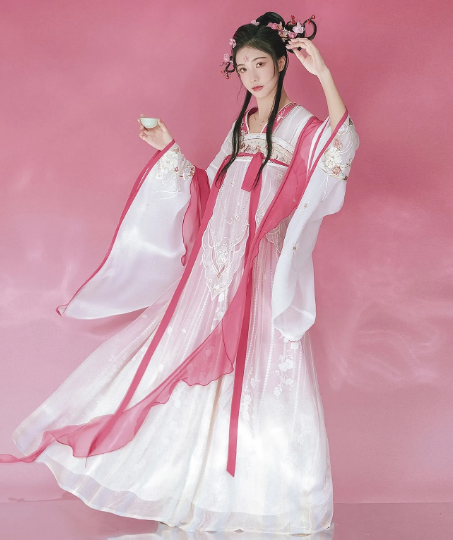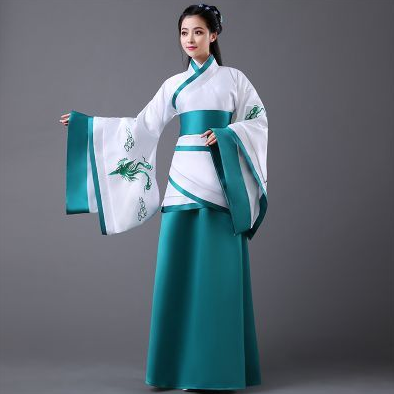Hanfu: The Classic Attire of the Han Dynasty
Hanfu, originating from the Han Dynasty, marks a significant part of Chinese cultural identity. This traditional attire, often seen in historical dramas, reflects ancient aesthetics and social norms.
Evolution and Characteristics
Hanfu has evolved over centuries, adapting to the changing fashion and social needs. Early designs were simple, prioritizing comfort and ease of movement. Over time, the attire became more elaborate, integrating intricate patterns and luxurious fabrics like silk. Hanfu typically consists of a robe or a shirt and a skirt, fastened with sashes. The wide sleeves and crossed collars symbolize traditional Chinese beauty. The garment’s flow and elegance make it a symbol of cultural pride and are often a staple in festivities and cultural events. You can explore more about Hanfu’s evolution on Hanfu’s Wikipedia page.

Variations Across Different Social Classes
Hanfu styles varied significantly across different social classes. The nobility often wore Hanfu made of finer materials and with more intricate designs. Their clothes would usually feature dragon, phoenix, or floral patterns, indicating wealth and status. In contrast, commoners’ Hanfu was simpler, made of cheaper materials like linen, and lacked elaborate decorations. Despite these differences, the fundamental structure remained consistent, demonstrating the unifying nature of Hanfu in Chinese culture. For more in-depth details on the social implications of Hanfu, check Social Class and Clothing in Ancient China.
Shenyi: The Formal Ensemble
Shenyi, a traditional Chinese garment, serves as a formal and ceremonial dress in ancient China. It combines a tunic and a skirt into a single piece, reflecting elegance and dignity.
Design and Symbolism
The Shenyi’s design, uniting the upper and lower garments, symbolizes the unity and integrity of the person wearing it. It often features wide sleeves and a belt to cinch the waist, highlighting the wearer’s form. Made typically of silk, Shenyi represents nobility, moral integrity, and respect. Its colors vary, each symbolizing different virtues or ranks in society. Black and blue are common, representing solemnity and depth. Further insights into Shenyi’s symbolism can be explored on Traditional Chinese Clothing.
Historical Significance and Usage
Historically, scholars and officials predominantly wore Shenyi during formal occasions like court assemblies or rituals. It signifies respect towards the event or people involved. Shenyi’s usage also marked significant life events such as weddings, suggesting its crucial role in ancient Chinese customs. Its relevance extends beyond mere clothing, encapsulating values, social order, and historical customs integral to Chinese heritage. For a deeper understanding of Shenyi’s role in Chinese history, one might find Chinese Ritual and Court Dress informative.
Ruqun: The Traditional Women’s Wear
Ruqun, a quintessential attire for women in ancient China, stands out for its grace and simplicity. It mainly consists of a blouse (Ru) and a wrap-around skirt (Qun).
Structure and Styles
The Ruqun varies greatly in styles, influenced by factors like age, marital status, and seasons. The blouse usually has a cross-collar, tying to the right. The skirt wraps around the body, extending from the waist to the ankles or even the ground, depending on the style and occasion. Some Ruquns have shorter blouses for young girls, while married women often wear longer ones. The garment uses materials like silk, cotton, and linen, with silk being the most popular for its smooth texture and vibrant colors. Details about different styles and materials are available on Ruqun Styles.
Cultural and Artistic Influence
Ruqun not only serves as clothing but also plays a crucial role in Chinese art and culture. Artists often depict legendary heroines and immortal figures in Ruqun, symbolizing ethereal beauty and virtue. The attire also appears in traditional Chinese performances like opera and dance, embodying the elegance and poise of the characters. This influence reflects the deep cultural roots and aesthetic values that Ruqun contributes to Chinese heritage. For an insight into its impact on Chinese art, one might explore Traditional Chinese Art.
Zhiduo/Zhishen: The Monastic and Scholarly Garments
Zhiduo and Zhishen, predominantly worn by Chinese scholars and monks, symbolize a lifestyle devoted to intellectual and spiritual pursuits.
Distinctions and Designs
Zhiduo, typically worn by scholars, features a straight collar and wide sleeves, mirroring the wearer’s pursuit of simplicity and knowledge. Made primarily of cotton or linen, it offers comfort, facilitating ease of movement and thought. The Zhishen, donned by Buddhist monks, appears similar but often incorporates additional religious symbols and comes in colors like grey or maroon, signifying different Buddhist sects and ranks. The garment’s loose fit reflects the detachment from materialistic life and a focus on spiritual growth. Further details on these garments’ designs can be found on Traditional Monastic Attire.
Influence on Modern Chinese Fashion
Both Zhiduo and Zhishen have significantly influenced modern Chinese fashion. Designers often incorporate their simple cuts, muted colors, and comfortable fabrics into contemporary clothing. This fusion results in outfits that are not only stylish and modern but also carry the essence of traditional wisdom and spirituality. Such trends demonstrate how ancient philosophies and aesthetics continue to resonate in today’s fashion world. For an overview of how traditional attire influences modern fashion, Modern Chinese Fashion provides comprehensive insights.
Tangzhuang: The Flourishing Tang Dynasty Apparel
Tangzhuang, deriving its name from China’s Tang Dynasty, stands as a vibrant testament to one of China’s golden ages in fashion.
Aesthetic Elements and Materials
Characterized by bright colors and elaborate designs, Tangzhuang often features patterns like dragons, phoenixes, and floral motifs, symbolizing prosperity and happiness. Common materials include silk and brocade, known for their luxurious sheen and intricate weaving. The attire typically presents a straight silhouette with broad sleeves and high collars, showcasing the flamboyance and openness of Tang Dynasty culture. Artisans paid immense attention to detail and quality, ensuring each piece was both visually stunning and durable. For an insight into its aesthetic elements, see Tang Dynasty Fashion.

Tangzhuang in Contemporary Fashion
In contemporary fashion, designers often reinterpret Tangzhuang to blend ancient elegance with modern sensibilities. This fusion brings the past into the present, allowing wearers to celebrate their heritage in a style that suits modern life. Contemporary Tangzhuangs are popular during festivals, weddings, and other celebrations, demonstrating their enduring appeal and versatility. Modern adaptations use a variety of fabrics and styles, making them accessible and fashionable for a wide audience. To explore more about Tangzhuang’s influence on modern fashion, check out Modern Interpretations of Traditional Chinese Clothing.
Dragon Robe (Longpao): The Imperial Garment
The Dragon Robe, or Longpao, is a distinguished type of clothing once exclusive to Chinese emperors, symbolizing supreme power and authority.
Symbolism and Craftsmanship
Every aspect of the Dragon Robe, from colors to patterns, carries deep symbolism. The dragons embroidered or woven on the robe, chasing flaming pearls among clouds, represent the emperor’s divine right to rule and his potent power. Typically, the primary color of the robe is yellow, a color traditionally reserved for the emperor, denoting centrality and supreme dignity. Craftsmen used silk for its texture and luster, painstakingly embroidering the robe with gold and silver threads to highlight the emperor’s splendor. This intricate process could take several months, reflecting the robe’s significance and the craftsmanship’s value. More on the symbolism can be found at Imperial Symbols in Chinese Art.
Variations and Historical Evolution
Over different Chinese dynasties, the style and design of the Dragon Robe evolved. Earlier robes were simpler, with fewer dragons and decorative elements. However, during the Ming and Qing Dynasties, the design became more elaborate, with multiple dragons and other motifs like waves, mountains, and the sun, indicating the emperor’s power extending to all corners of the realm. This evolution in style mirrors changes in political and cultural ideologies throughout China’s history. The transformation of the Dragon Robe over time provides insight into the evolving conception of imperial authority and artistry. A detailed examination of these changes can be explored in History of Chinese Imperial Fashion.